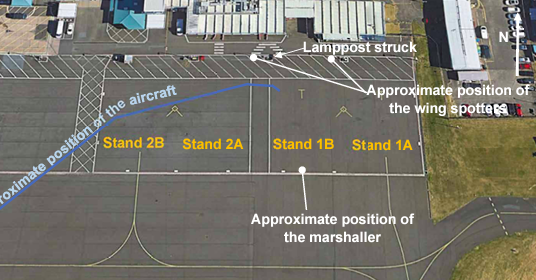Lessons Learned: Pilot Collides with Lamppost While Watching Marshaller

With a marshaller working the main apron, the left wingtip of the aircraft collided with a lamppost.
Neither the flight crew nor the marshaller at Dundee airport were aware how close the wingtip was to the lamppost. Wing spotters positioned to mitigate this risk saw the impending collision and attempted to signal the aircraft to stop but neither the flight crew nor the marshaller saw the signals.
The airport operator intends to enhance its guidance to ground crew. The aircraft operator issued a notice to its pilots reminding them about standard marshalling signals.
The aircraft landed on Runway 27 at Dundee Airport at 0847 hrs and was instructed to vacate via Taxiway B and park nose to the south on Stand 1B with the marshaller. It was daytime and CAVOK (Ceiling and Visibility OK). A marshaller was positioned at the head of the stand and two “wing spotters” were positioned on the end of the apron. Another aircraft was already parked on the adjacent stand.
The marshaller started marshalling the aircraft as it approached the apron, and the flight crew followed the instructions. As the aircraft approached the edge of the apron both wing spotters could see that a collision was imminent and attempted to signal to the marshaller and the flight crew to stop the aircraft. However, the marshaller was looking at the aircraft and the flight crew were looking at the marshaller so neither saw the signals from the wing spotters. The winglet on the left wingtip collided with a lamppost on the edge of the apron and the aircraft came to an abrupt halt.
CCTV evidence showed the wing spotters started to signal the aircraft to stop 4 seconds before the collision.
Safety recommendations
Following the airport operator’s investigation into this occurrence, it commented that the white hatched area at the top of the apron is intended as a safety buffer zone.
- No part of the aircraft should enter this area whilst maneuvering. It intends to instruct wing spotters to stand on the outer edge of the buffer zone rather than inline with the lampposts, to ensure the buffer is maintained.
- It also intends to: 1. Conduct a review of its marshalling training package. 2. Consider the introduction of direct headset communications between marshaller and wing spotters. 3. Consider a two-stage marshalling process with two marshallers for circumstances similar to the accident. The aircraft operator issued an Operational Order to all its pilots reminding them about standard marshalling signals.
Content/photo source/credit: AAIB (Air Accidents Investigation Branch), “AAIB investigation to Bombardier Challenger 350, LN-JHH,” published December 14, 2023.
Sign up for a TapRooT® Root Cause Analysis Training Course
Circumstances can crop up anywhere at any time if proper and safe sequence and procedures are not planned and followed. We encourage you to learn and use the TapRooT® System to find and fix problems.
TapRooT® has a team of investigators and instructors with years of extensive training ready to offer assistance worldwide. We also offer ongoing support to our clients through free newsletters and Root cause tip videoS, the root cause analysis blog, and our annual Global TapRooT® Summit.
Register for one of our courses. We offer a basic 2-Day course and an advanced 5-Day course.
Contact us or call 865.539.2139 about having a course at your site or for further root cause analysis opportunities. We’re here to find solutions for you.
TapRooT® courses are taught all over the world; if you need specific times or locations, please see our full selection of courses.



